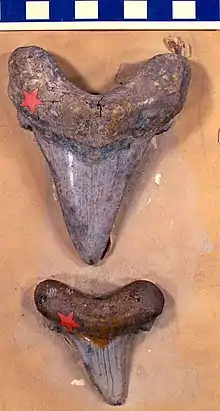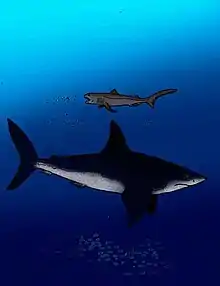Otodus auriculatus
Otodus auriculatus[1] is an extinct species of large sharks in the genus Otodus of the family Otodontidae, closely related to the sharks of the genus Otodus, and also closely related to the later species megalodon. Its teeth were large, having coarse serrations on the cutting edge, and also with two large cusplets. The teeth can reach up to 130 millimetres (5.1 in), and belonged to a large "megatoothed" shark.
| Otodus auriculatus | |
|---|---|
 | |
| Teeth from Craven County, North Carolina | |
| Scientific classification | |
| Kingdom: | Animalia |
| Phylum: | Chordata |
| Class: | Chondrichthyes |
| Order: | Lamniformes |
| Family: | †Otodontidae |
| Genus: | †Otodus |
| Species: | †O. auriculatus |
| Binomial name | |
| †Otodus auriculatus Blainville, 1818 | |
| Synonyms | |
| |
Assignment to the genus Carcharocles rather than Otodus

It is known that there is at least one genus in the family Otodontidae, that being Otodus. But the names and number of the genera in Otodontidae is controversial and the family's accepted phylogeny varies among paleontologists in different parts of the world. In the US and Britain the most widespread genus name for otodontids with serrated teeth is Carcharocles, and the owners of unserrated ones Otodus. In countries of the former USSR, like Ukraine or Russia, all of these genera were attributed to Otodus, because scientists like Zhelezko and Kozlov[2] thought that the absence or presence of tooth serrations is not enough to place these sharks in different taxa.
Size
The tooth length of O. auriculatus is relatively large - from 25 to 114 millimetres (0.98 to 4.49 in).[3] However, it is smaller than that of megalodon and Otodus angustidens; the tooth length of O. megalodon is 38 to 178 millimetres (1.5 to 7.0 in) and O. angustidens 25 to 117 millimetres (0.98 to 4.61 in).[3]
Distribution
Most O. auriculatus teeth come from South Carolina and North Carolina.[3] However, many Eocene shark teeth are known from Khouribga Plateau, in Morocco. Fossil teeth have also been found in the United Kingdom and Kazakhstan, and the shark enjoyed a fairly global distribution. [4]
References
- Shimada, K.; Chandler, R. E.; Lam, O. L. T.; Tanaka, T.; Ward, D. J. (2016). "A new elusive otodontid shark (Lamniformes: Otodontidae) from the lower Miocene, and comments on the taxonomy of otodontid genera, including the 'megatoothed' clade". Historical Biology. 29 (5): 1–11. doi:10.1080/08912963.2016.1236795. S2CID 89080495.
- Zhelezko, Kozlov (1999). Elasmobranch and biostratigraphy of Trans-Urals and Central Asia.
- Joe Cocke (2001). Fossil Shark Teeth of the World.
- Fossil Teeth (PDF). Archived from the original (PDF) on 2012-03-27. Retrieved 2011-07-18.